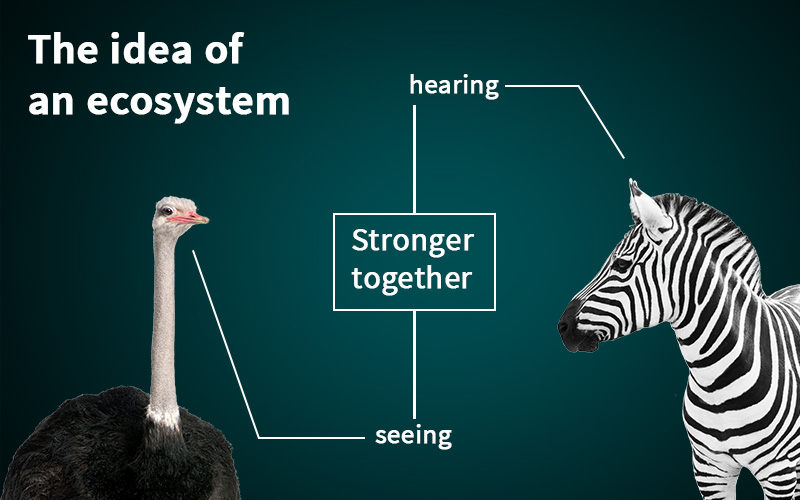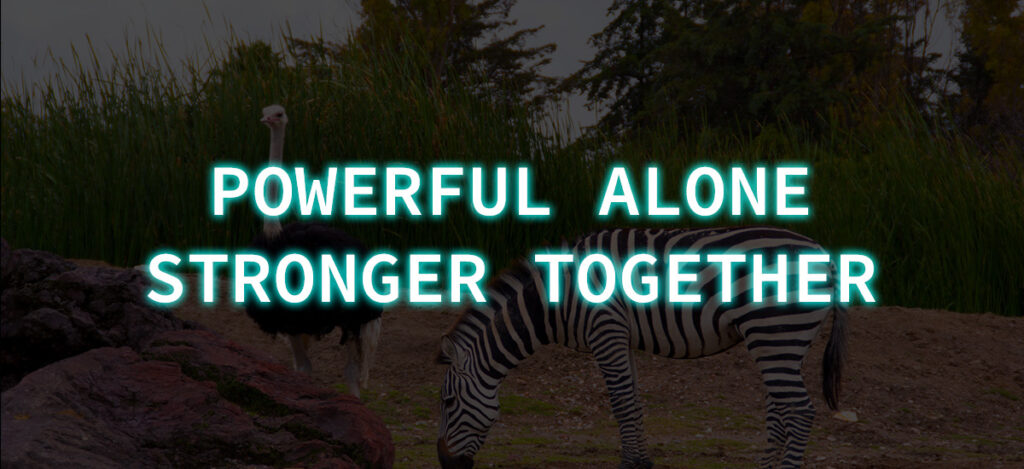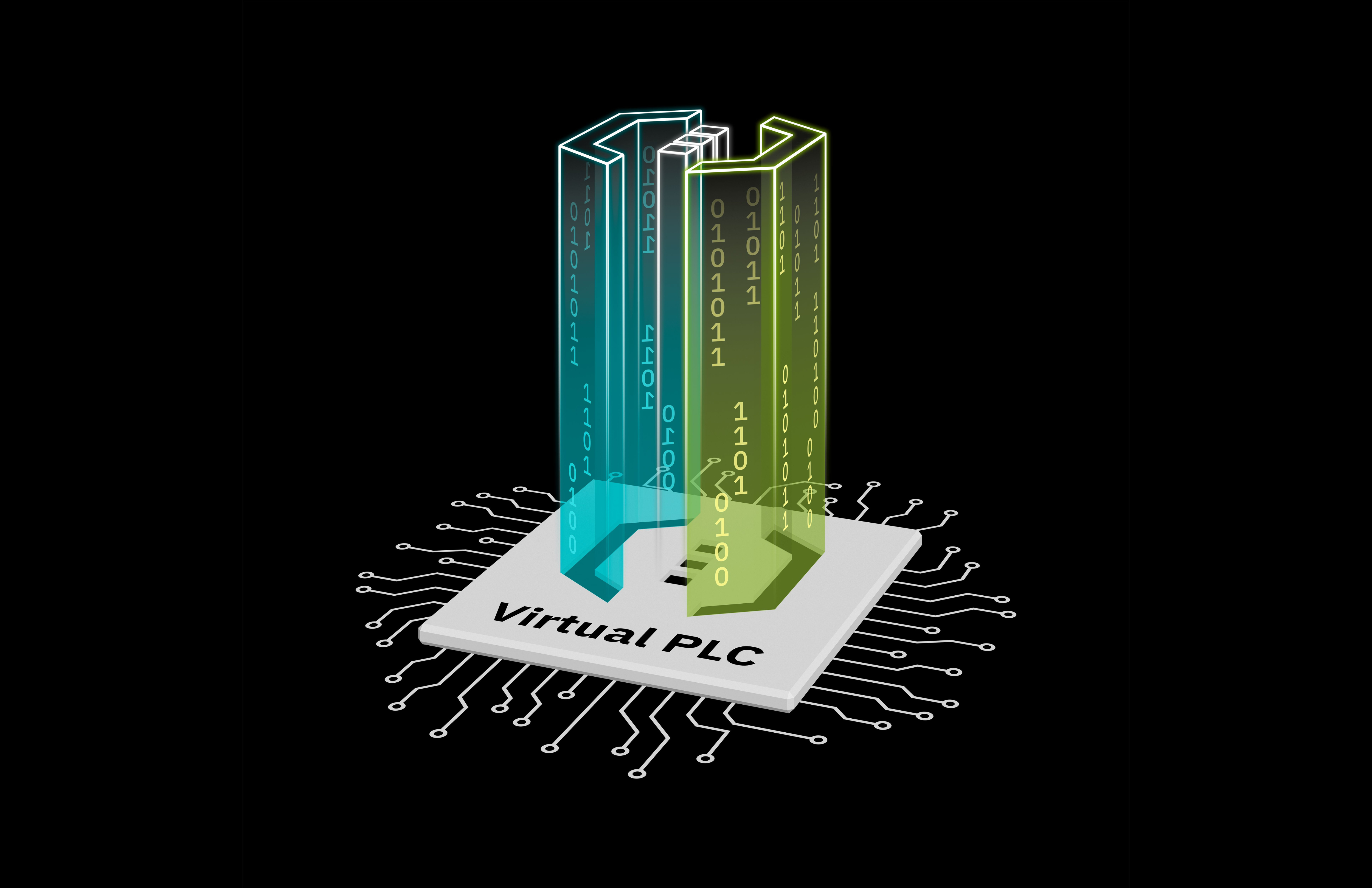
If you google “open ecosystem” you will get more than 237 Mio. hits. In the industrial world there is no getting around ecosystems – there is no doubt about that. Clearly, a shift from traditional innovation systems towards open innovation ecosystems can be observed. But why and for whom is that beneficial? And how does that affect the way we work together in the industrial environment?
In this article, we shed light on the buzzword jungle of open ecosystems and digital platforms. We show which opportunities and power these systems will bring to the automation industry and how they will change the way companies work together.
Open ecosystems – more than a buzzword?
The term ecosystem has its origin in nature where it describes “the complex of living organisms, their physical environment, and all their interrelationships in a particular unit of space”
(www.Britannica.com). Over the past years it became hijacked by the business management community as a concept of an interconnected partner network. Industrial ecosystems encompass all players operating in a value chain: from the smallest start-ups to the largest companies, from academia to research, from service providers to suppliers. The goal of the ecosystem is to form a digital value creation network from which all involved benefit. Open ecosystems enable companies to partner in areas where they would otherwise never be able to play. On the one hand, this enables the solutions to be extended to new customer bases and new markets, and on the other hand, it expands the range of products and services available to the customer.
But is this just pure theory or lived practice? And are open ecosystems really worth it?
The relevance of open ecosystems on our way to industry 4.0
As always, we can learn a lot from nature. From Ostriches and Zebras for example. On first sight these two animals couldn’t be more different. And yet, they have something in common: they are often at risk of falling prey to lions. This is why they have teamed up. The great thing about their partnership is the particular reason they choose each other. Ostriches have very good eyesight but cannot hear very well. Zebras, on the other hand, cannot see very well, but can hear excellently. Together, they are better able to detect impending danger, so they group together for protection. So, by contributing their respective strengths, they mutually benefit from each other.
Open ecosystems follow the same principle: the strength of the ecosystem results from the specific competencies of the contributors. Instead of trying to offer everything on your own, it makes sense to bundle the industry’s competencies and incorporate expert knowledge.
And also the reason for the cooperation within open ecosystems is transferable from the world of Ostriches and Zebras in a way: it is important not to be eaten!
In our digitally driven world with shortening innovation cycles and a rapid pace of technology advances it becomes crucial to have an agile, responsive and open technology to keep a strategic advantage. The ability to work effectively in a flexible ecosystem model, with a willingness to share and collaborate has become the key to success. Closed-platform vendors will have trouble keeping up with their customers’ needs because they are limited by their own R&D departments and their own imagination. In a closed ecosystem, users cannot make changes themselves and partners are locked out from creating helpful add-ons. Even the largest companies cannot meet the demands of every single unique audience they hope to serve. Without an open platform, they will eventually have to turn away those users. And sooner or later these companies may be eaten.
And the benefits are not just on the suppliers’ side – there’s much more to it than that. Customers also derive great benefit. Thanks to the available expert know-how, they receive solutions that can easily be implemented and are able to match shorter innovation cycles. And the customers are not simply on the buying side. They are an inevitable part of the ecosystem itself! With their automation projects and the associated problem situations, they are key drivers for new, innovative solutions. Their feedback is fundamental for a continuous improvement of the ecosystem offering.
So clearly, open ecosystems pose tremendous potential for stakeholders on all sides. The question is: are we ready to fully exploit this potential yet? Or does it require a new mindset among all players involved?
How open is really open? It´s a matter of mindset!
We have seen that as innovation cycles shorten, automation systems must be able to be adapted ever more quickly in the future. And we have seen that open ecosystems perfectly match with that requirement. One crucial success factor for an open ecosystem to really be open is the willingness to be open. And that is, to a large extent, a basic attitude, and a clear commitment.
For many companies this means a change in thinking, changes in processes and other approaches. For example, many further developments and innovations will be created primarily by communities and the creativity of many idea providers. Know-how will have to be purchased more often in the future than it has in the past. Flexibility and a real willingness to cooperate rather than to compete will become the most urgent requirement for us all. That means, saying good-bye to the conservative attitude of wanting to invent everything yourself and instead embracing the idea of reusing what has already been developed and proven and participating with your expertise and know-how. To sum it up: to exploit the full potential of open ecosystems, we need the openness in our minds.
Competition, cooperation or coopetition – how do open ecosystems change the way we work together?
In a recent article, “The Emerging Art of Ecosystem Management” published by the Boston Consulting group it says:
“The members of today’s industry ecosystems collaborate in ways that are fundamentally different from collaborations of the past.”
The Emerging Art of Ecosystem Management (bcg.com)
Definitely, ecosystems push companies to rethink how they interact with their partners. Ok, to tell the truth, in recent years, the collaboration of companies in the industrial environment has already changed. In addition to the idea of competition, there was of course also a willingness to cooperate – and that was even before open ecosystems became a high priority topic. However, truly successful ecosystems need more than traditional partner management. We need to change our minds and get beyond this. It’s not about announcing partnerships, instead, it’s about the joint goal to innovatively drive solutions. Being really open means to be really open: open to connect with other systems, open for anyone to contribute with expertise and know-how.
Apart from the willingness to work together in an open ecosystem, it needs the infrastructure to do so. Digital platforms are a central element of it.

The role of digital platforms
If ecosystem is called a buzzword the same is true for platform. There are numerous definitions to describe the term. In the industrial environment or maybe even more specific, in the automation industry, it could perhaps be formulated as follows: digital platforms contain a common set of functions with the aim of providing solutions more quickly. Digital platforms help to establish connections within an ecosystem of previously disparate devices, software and service providers.
Platforms and digital marketplaces are established in the B2C environment. In recent times digital platforms and platform business models are also experiencing steadily increasing relevance in the B2B sector. On the path to Industry 4.0 they pose the opportunity to raise new potentials. Just how much potential digital platforms have, was impressively demonstrated by Apple. Before 2008, the software industry was dominated by a few large companies. In 2008 Apple launched the first app store. Apple opened the doors for third-party developers and brought a whole new experience into the hands of customers. Every developer, from “one-man businesses” to large studios, were suddenly able to realize great ideas by developing a high-quality app and delivering it to the ever-growing number of customers without much effort. Virtually anyone could build on top of the open platform. And the reward for Apple’s courage to be open was outstanding: the company achieved almost a tenfold increase in revenue just within one quarter. Since then, the App Store has grown to offer millions of apps to one billion App Store customers worldwide. The mobile app world has become an indispensable part of our daily life. And this is not only true for our private life – over time it has increasingly become important in industrial environments as well.
Whereas only a few years ago, proprietary software was state of the art, open systems now invite software experts to contribute to the ecosystem with their smart software solutions. This approach clearly advocates innovation in the field of automation industry. And this benefits everyone. The software developers get access to a new customer base. And the project engineers of complex automation projects can realize their tasks with the help of smart apps even faster.
And the beauty of it: the more participants in the ecosystem, the merrier. Open ecosystems grow stronger over time because as their adoption increases, more tools and services pop up around them, which leads to further adoption. More users attract more contributors, and more contributors attract more users.
The relevance which an open ecosystem has for the market is just as important for the product owners than it is for the customers, as the latter one relies on a futureproof system. An essential part of an open ecosystem is an active community that encompasses all aspects of the ecosystem.
The role of communities to keep open ecosystems futureproof
The ecosystem community – that is the entirety of the global network of relationships within the ecosystem. The community, that is everyone involved: from hardware and software suppliers, service providers, system integrators and distributors to users – just to name a few. A strong community is what makes the difference. Products may be comparable as well as software solutions. However, the knowledge and the network of the community are the real treasures of the open ecosystem. The community is the place within which participants of the ecosystem can have exchange. It is the place where trends are being discussed and standards are being agreed upon. It is the place where the company’s ear is as close to the market and its requirements as it gets. It is the essential asset for a company to ensure to keep up with the market development and remain equipped for the future.
To sum it up:
In conclusion we can state:
- Open ecosystems are ideally suited to meet the challenges of rapidly changing market situations
- Successfully working in open ecosystems requires a true mindshift
- Open ecosystems will fundamentally change the way of collaboration in the industrial environment
- On the path to Industry 4.0 digital platforms pose a major opportunity to raise new potentials and
- Community is the key
Closing, let’s take a final look at nature’s ecosystems. One factor that unites them all is a certain susceptibility to disturbance. All participants of the ecosystem are connected with each other through a web of relationships, all participants of the ecosystem have their role. It is of highest priority to maintain this fragile balance to keep up the attractiveness for everybody and to keep the ability to react and adapt to changes in conditions. All players need to contribute with their know-how and expertise, and it needs to be ensured that benefits are shared by all. Only this maintains the important ecosystem balance. If that succeeds, then immeasurable possibilities lie ahead – in nature just as much as in industrial ecosystems.
With this article you have gained deep insights into the DNA of PLCnext Technology: open mindset, willingness to drive innovation, the strive to be meet all the challenges of the IoT world and the conviction, that this will only be possible together with strong partners. All this makes PLCnext Technology a pioneer of its kind and a true success story. Be part of it!




